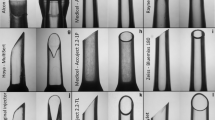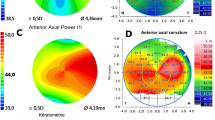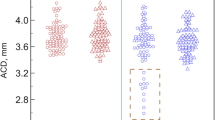Abstract
Purpose
To compare intraocular lens implantation using a motorized injector vs standard manual injector through a 2.2-mm clear corneal incision.
Methods
Patients underwent standard phacoemulsification using a 2.2-mm clear corneal incision. Hydrophobic acrylic aspheric intraocular lens (Acrysof SN60WF intraocular lens (IOL)) was inserted using D cartridge with manual monarch injector or autosert motorized injector. IOL safety, final incision size and wound integrity in terms of anterior and posterior wound gape, and descemet’s membrane detachment were compared between the two groups at post-operative day 1 and at 1 month using Anterior Segment Optical Coherence Tomography.
Results
The study recruited 32 patients in the group I (manual injector) and 30 patients in group II (motorized injector). In group I, the final incision after IOL insertion increased by 0.12 mm (95% CI: 0.134–0.106) (P<0.0001), which was seen in 100% of the patients. In group II, the incision enlarged by 0.01 (95% CI: 0.021–0.0.001) (P=0.07) and was seen in only 6.67% of the cases. IOL nicks were seen in 9.37% of the cases in group I only. Although the incidence of descemet’s membrane detachment and anterior wound gape was similar for both groups, posterior wound gape was seen more often with the manual injector in the immediate post-operative period. (P=0.018)
Conclusion
The motorized insertion system was gentle and safe for the IOLs with lesser incidence of IOL nicks. Regarding wound safety, it caused significantly less incision enlargement and better posterior wound integrity.
Similar content being viewed by others
Log in or create a free account to read this content
Gain free access to this article, as well as selected content from this journal and more on nature.com
or
References
Leaming DV . Practice styles and preferences of ASCRS members-survey 2001. J Cataract Refract Surg 2002; 28: 1681–1688.
Leaming DV . Practice styles and preferences of ASCRS members—1985 survey. J Cataract Refract Surg 1986; 12: 380–384.
Leaming DV . Snapshots [guest editorial]. J Cataract Refract Surg 2006; 32: 1401–1402.
Kohnen T, Dick B, Jacobi KW . Comparison of the induced astigmatism after temporal clear corneal tunnel incision of different sizes. J Cataract Refract Surg 1995; 21: 417–424.
Masket S, Wang L, Belani S . Induced astigmatism with 2.2- and 3.0-mm coaxial phacoemulsification incisions. J Refract Surg 2009; 25: 21–24.
Hayashi K, Yoshida M, Hayashi H . Postoperative corneal shape changes: microincision versus small-incision coaxial cataract surgery. J Cataract Refract Surg 2009; 35: 233–239.
Elkady B, Pinero D, Alio JL . Corneal incision quality: microincision cataract surgery versus microcoaxial phacoemulsification. J Cataract Refract Surg 2009; 35: 466–474.
Allen D, Habib M, Steel D . Final incision size after implantation of a hydrophobic acrylic aspheric intraocular lens: new motorized injector versus standard manual injector. J Cataract Refract Surg 2012; 38: 249–255.
Wang L, Dixit L, Weikert MP, Jenkins RB, Koch DD . Healing changes in clear corneal cataract incisions evaluated using Fourier-domain optical coherence tomography. J Cataract Refract Surg 2012; 38: 660–665.
Kohnen T, Klaproth OK . Incision sizes before and after implantation of SN60WF intraocular lenses using the Monarch injector system with C and D cartridges. J Cataract Refract Surg 2008; 34: 1748–1753.
Espiritu CR, Bernardo JP Jr . Incision sizes at different stages of phacoemulsification with foldable intraocular lens implantation. J Cataract Refract Surg 2009; 35: 2115–2120.
Steinert RF, Deacon J . Enlargement of incision width during phacoemulsification and folded intraocular lens implant surgery. Ophthalmology 1996; 103: 220–225.
Moreno-Montanes J, Garcia-Layana A, Aliseda D, Munuera JM . Variation in clear cornea incision size after phacoemulsification and foldable lens implantation. J Cataract Refract Surg 1998; 24: 931–934.
Moreno-Montañés J, Maldonado MJ, García-Layana A, Aliseda D, Munuera JM . Final clear corneal incision size for AcrySof intraocular lenses. J Cataract Refract Surg 1999; 25: 959–963.
Radner W, Menapace R, Zehetmayer M, Mallinger R . Ultrastructure of clear corneal incisions. Part I: effect of keratomes and incision width on corneal trauma after lens implantation. J Cataract Refract Surg 1998; 24: 487–492.
Ouchi M . Effect of intraocular lens insertion speed on surgical wound structure. J Cataract Refract Surg 2012; 38: 1771–1776.
Kohnen T, Kasper T . Incision sizes before and after implantation of 6-mm optic foldable intraocular lenses using Monarch and Unfolder injector systems. Ophthalmology 2005; 112: 58–66.
Osher RH . Microcoaxial phacoemulsification. Part 2: clinical study. J Cataract Refract Surg 2007; 33: 408–412.
Fine IH, Hoffman RS, Packer M . Profile of clear corneal cataract incisions demonstrated by ocular coherence tomography. J Cataract Refract Surg 2007; 33: 94–97.
Lyles GW, Cohen KL, Lam D . OCT-documented incision features and natural history of clear corneal incisions used for bimanual microincision cataract surgery. Cornea 2011; 30: 681–686.
Torres LF, Saez-Espinola F, Colina JM, Retchkiman M, Patel MR, Agurto R et al. In vivo architectural analysis of 3.2 mm clear corneal incisions for phacoemulsification using optical coherence tomography. J Cataract Refract Surg 2006; 32: 1820–1826.
Dupont-Monod S, Labbe A, Fayol N, Chassignol A, Bourges JL, Baudouin C . In vivo architectural analysis of clear corneal incisions using anterior segment optical coherence tomography. J Cataract Refract Surg 2009; 35: 444–450.
Chee SP, Ti SE, Lim L, Chan AS, Jap A . Anterior segment optical coherence tomography evaluation of the integrity of clear corneal incisions: a comparison between 2.2-mm and 2.65-mm main incisions. Am J Ophthalmol 2010; 149: 768–776.
Gupta PK, Ehlers JP, Kim T . Evaluation of clear corneal wound dynamics with contrast-enhanced spectral-domain optical coherence tomography. Ophthalmic Surg Lasers Imaging 2012; 43: 222–228.
Author information
Authors and Affiliations
Corresponding author
Ethics declarations
Competing interests
The authors declare no conflict of interest.
Rights and permissions
About this article
Cite this article
Khokhar, S., Sharma, R., Patil, B. et al. Comparison of new motorized injector vs manual injector for implantation of foldable intraocular lenses on wound integrity: an ASOCT study. Eye 28, 1174–1178 (2014). https://doi.org/10.1038/eye.2014.162
Received:
Accepted:
Published:
Issue date:
DOI: https://doi.org/10.1038/eye.2014.162
This article is cited by
-
In vivo and in vitro results of an automated preloaded delivery system for IOL implantation in cataract surgery
International Ophthalmology (2020)
-
Corneal incision architecture after IOL implantation with three different injectors: an environmental scanning electron microscopy study
International Ophthalmology (2019)
-
Comparison of two techniques for toric intraocular lens implantation: hydroimplantation versus ophthalmic viscosurgical devices
BMC Ophthalmology (2018)
-
A different approach for manual foldable IOL injection for keeping wound size and integrity
Eye (2015)



